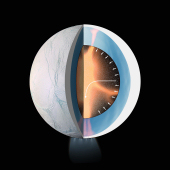ESA Science & Technology - News Archive
News archive
News archive
ESA’s Matt Taylor has been awarded the 2018 Service Award for Geophysics by the Royal Astronomical Society for his outstanding contribution to the Rosetta mission, while the Planck mission has been honoured with the Group Achievement Award for their extraordinary achievements in cosmology.
Published: 12 January 2018
The Council of the European Space Agency announced the appointment of Günther Hasinger as the next Director of Science. He will succeed Alvaro Giménez, who has served in the position since 2011.
Published: 14 December 2017
A riot of colour and light dances through this peculiarly shaped galaxy, NGC 5256. Its smoke-like plumes are flung out in all directions and the bright core illuminates the chaotic regions of gas and dust swirling through the galaxy's centre. Its odd structure is due to the fact that this is not one galaxy, but two – in the process of a galactic...
Published: 14 December 2017
Measuring the positions and motions of more than a billion stars, ESA's Gaia mission will refine our knowledge about our place in the Universe, providing the best ever star chart of our Milky Way and its neighbouring galaxies.
Published: 13 December 2017
Immense northern storms on Saturn can disturb atmospheric patterns at the planet's equator, finds the international Cassini mission. This effect is also seen in Earth's atmosphere, suggesting the two planets are more alike than previously thought.
Published: 13 December 2017
ESA's Science Programme Committee (SPC) has approved indicative extensions, up to 2019-2020, for the operation of eight scientific missions.
Published: 7 December 2017
Astronomers have used ESA's Herschel Space Observatory to solve a decades-old mystery about the origin of powerful cool gas winds in the hot environs of quasars. The evidence linking these powerful winds to star formation in the quasar host galaxies may also help resolve the mystery of why the size of galaxies in the Universe appears to be capped.
Published: 7 December 2017
A team of astronomers used data from both the NASA/ESA Hubble Space Telescope and ESA's Gaia satellite to directly measure the 3D motions of individual stars in a nearby galaxy.
Published: 27 November 2017
By pinning down, for the first time, the three-dimensional motions of individual stars in the nearby Sculptor dwarf galaxy, astronomers have shed new light on the distribution of invisible dark matter that pervades the galaxy.
Published: 27 November 2017
It's the perfect meeting of old and new. Astronomers have combined the latest data from ESA's Gaia mission with a simple analysis technique from the 18th century to discover a massive star cluster that had previously escaped detection. Now, subsequent investigations are helping reveal the star-forming history of our Galaxy, the Milky Way.
Published: 15 November 2017
What seemed at first like a rare instance of a huge, ancient galaxy revealed itself to be an even rarer pair of extremely massive galaxies, seen on the brink of merging when the Universe was only a billion years old.
Published: 13 November 2017
Gas giant Jupiter, organic molecules in star-forming clouds and baby galaxies in the distant Universe are among the first targets for which data will be immediately available from the James Webb Space Telescope once it begins casting its powerful gaze on the Universe in 2019.
Published: 13 November 2017
Enough heat to power hydrothermal activity inside Saturn's ocean moon Enceladus for billions of years could be generated through tidal friction if the moon has a highly porous core, a new study finds, working in favour of the moon as a potentially habitable world.
Published: 6 November 2017
ESA is offering graphic designers and artists a unique opportunity to feature their work on the rocket carrying the CHEOPS satellite.
Published: 2 November 2017
ESA and NASA space telescopes have revealed that, unlike Earth's polar lights, the intense auroras seen at Jupiter's poles unexpectedly behave independently of one another.
Published: 30 October 2017
Last year, a fountain of dust was spotted streaming from Rosetta's comet, prompting the question: how was it powered? Scientists now suggest the outburst was driven from inside the comet, perhaps released from ancient gas vents or pockets of hidden ice.
Published: 26 October 2017
Using the NASA/ESA Hubble Space Telescope, astronomers have discovered that the brightest galaxies within galaxy clusters "wobble" relative to the cluster's centre of mass. This unexpected result is inconsistent with predictions made by the current standard model of dark matter.
Published: 26 October 2017
An unprecedented catalogue of more than 21 000 images taken by a webcam on ESA's Mars Express is proving its worth as a science instrument, providing a global survey of unusual high-altitude cloud features on the Red Planet.
Published: 17 October 2017
The NASA/ESA Hubble Space Telescope has observed for the first time the source of a gravitational wave, created by the merger of two neutron stars. This merger created a kilonova – an object predicted by theory decades ago – that ejects heavy elements such as gold and platinum into space.
Published: 16 October 2017
ESA's INTEGRAL satellite recently played a crucial role in discovering the flash of gamma rays linked to the gravitational waves released by the collision of two neutron stars.
Published: 16 October 2017
—
20 Items per Page




















